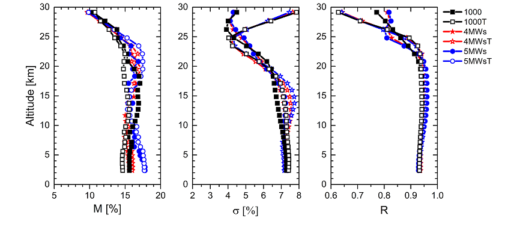The Scientific paper “Internal consistency of the Regional Brewer Calibration Centre for Europe triad during the period 2005 – 2016” has been published in the scientific journal Atmospheric Measurement techniques (AMT).
![]()
The Brewer Ozone Spectrophotometer has been the instrument chosen for ground station ozone measurements for the last 30 years. At present, there are more than 200 instruments installed around the world, 50 of them in Europe. The RBCC-E is the centre responsible for the European Brewer network calibration, organizing intercomparison and calibration campaigns with the travelling reference.
This work is focused on showing the internal consistency of the observations made by the RBCC-E triad (Brewer#157, #183 y #185) in the period 2005-2016 at the Izaña Atmospheric Observatory (IZO). With this idea in mind, the consistency of the RBCC-E is compared with the values reported for the Toronto (world reference) and Arosa Triads.
The long-term consistency of the total ozone column (TOC) measurements made by the RBCC-E triad has been studied and compared with the values reported for the world reference and Arosa triads. With this idea in mind, the procedure described by Fioletov et al. to evaluate the TOC measurements made by the world reference triad was used in this work. The relative daily standard deviation for each Brewer, σ157 = 0.362 %, σ183 = 0.453 %, and the triad mean, σ = 0.41 %, were calculated. The values obtained for RBCC-E are lower than the reported value for the world reference triad. In addition, applying the procedure described by Stübi et al. (2017) to study the Arosa triad, the RBCC-E triad presents a similar interpercentile range P2.5–P97.5, with a value close to 1.1 %, similar to those reported for the Arosa triad, except in the case of Brewer #040. Although the methodology used to study the world reference and Arosa triads are different, the standard deviation reported for these and RBCC-E triads are fairly similar, which indicate a large level of internal consistency between their instruments. However, in order to guarantee correct traceability of the ozone measurements all around the world, a greater frequency of Absolute Calibration Campaign between the calibration centre and the travelling standard reference is necessary.
Finally, the procedure to calculate the Extraterrestrial constant (ETC) from the Langley technique is described in this work.
The full reference is:
León-Luis, S. F., Redondas, A., Carreño, V., López-Solano, J., Berjón, A., Hernández-Cruz, B., and Santana-Díaz, D.: Internal consistency of the Regional Brewer Calibration Centre for Europe triad during the period 2005–2016, Atmos. Meas. Tech., 11, 4059-4072, https://doi.org/10.5194/amt-11-4059-2018, 2018.
The paper can be download at:
https://www.atmos-meas-tech.net/11/4059/2018/amt-11-4059-2018.pdf

RBCC-E team. From left to right : Alberto Redondas (AEMET), Alberto Berjon (ULL), proyecto ATMOZ),Javier López Solano (ULL, proyecto IDEAS),
Bentorey Hernandez (ULL, proyecto PANDONIA),Virgilio Carreño (AEMET), Manuel Rodríguez Valido (ULL), Daniel Santana (ULL,PANDONIA) y Sergio Fabián León Luis (AEMET).

Brewer #157, reference instrument of the Triad at the Izaña observatory.

The Triad of IZO during a campaign at the Terrace of the Izaña Observatory.

The travelling Brewer #185 at Arosa Observatory (Switzerland).







